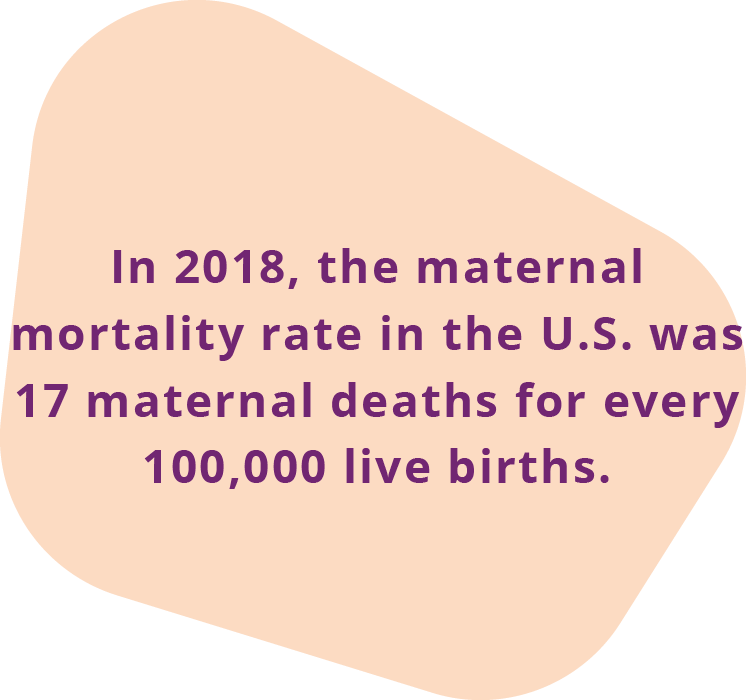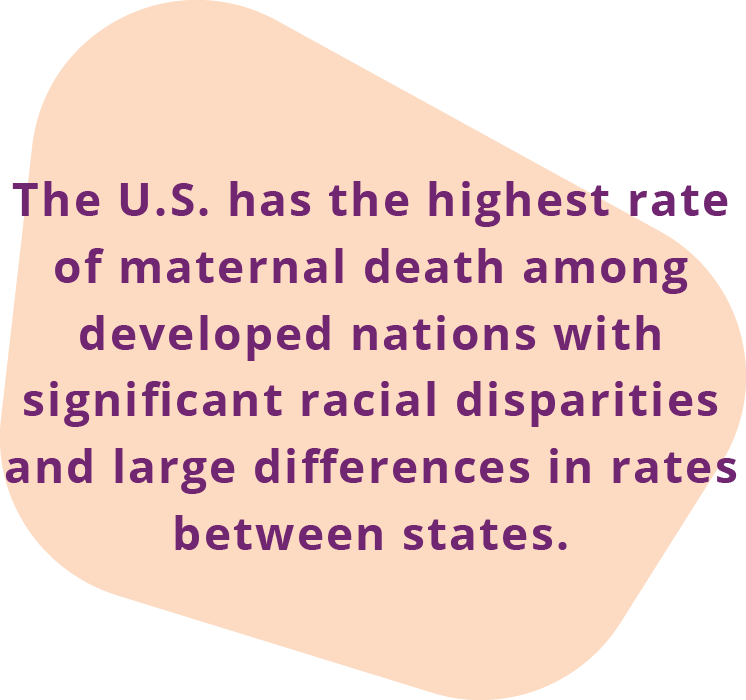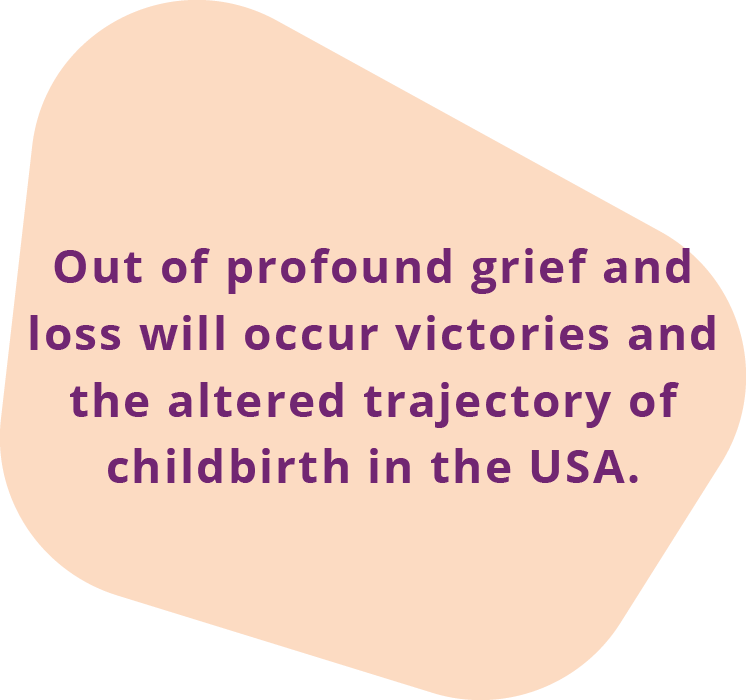Improving Maternal Health, Preventing Maternal Mortality
In 2018, the maternal mortality rate in the U.S. was 17 maternal deaths for every 100,000 live births. (CDC 2020). This equates to roughly 700 women who die each year as a result of pregnancy or delivery complications.
What is Maternal Mortality?
Mortality: A mortality rate is a measure of the frequency of occurrence of death in a defined population during a specified interval, in this case, related to maternal deaths related to pregnancy and birth.
Pregnancy-related death can happen during pregnancy, at delivery, and even up to a year afterward (postpartum). Maternal deaths are only the tip of the iceberg of this tragic reality, because for every woman who dies; many more survive but are often affected with lifelong disabilities. (Kalhan et al, 2017).
Morbidity is another term frequently used: For every instance of maternal death, there are approximately 100 women who experience a “near miss.” A “near miss” has been defined as “a woman who nearly died, but survived a complication that occurred during pregnancy, childbirth or within 42 days of termination of pregnancy.

Why is the U.S. Maternal Mortality Rate So High?
It is suggested that pregnancy-related mortality is largely due to delays in:
- The decision to seek appropriate medical help for an obstetric emergency (by the birthing person or medical provider).
- Accessing an appropriate obstetric facility.
- Receiving acceptable care when once admitted to an appropriate facility. (Barnes-Josiah et al 2018).
- Racial and ethnic disparities: non-Hispanic Black women are more than 3 times more likely to have a maternal death than white women in the United States regardless of geography, socio-economic status, education, health insurance status or access to high quality care (Melillo, 2020. ProPublica, 2017).
U.S. Maternal Mortality Compared to Other Developed Countries
- The U.S. has the highest rate of maternal death among developed nations with significant racial disparities and large differences in rates between states.
- In addition, the U.S. maternal mortality rates have worsened over the last 15 years, at a time when rates in other countries have improved.
- Of particular concern is that the U.S., is classified as a “high-income” country with economic strengths and needs, as well as a “comfortable” standard of living experienced by the average citizen. This also includes having the most expensive health care system.
- The country’s maternal mortality rate is more than 3 times higher than comparative developed countries. It’s a hard pill to swallow in 2021 when maternal deaths occur at a higher rate in the U.S. than in many low- and middle-income countries globally.
In the last few years, the state of maternal mortality in the United States has received widespread and justified attention. All too often this is following a tragic loss of a mother during or shortly after giving birth. The long-term effects of this devastating event have numerous ramifications that vary be individual and are not limited to the emotional pain and trauma experienced by loved ones and an innocent infant who will never know their mother.

Improvement Strategies
Up to 60% of pregnancy-related deaths are deemed preventable, according to research and data.
Exposing these devastating statistics has sounded the alarm for both corrective and preventative action. These interventions are multi-level and multi-sectoral and range from national, to state, to the local and individual level. Below are some of the many programs that have been implemented to help identify, reduce and eliminate the incidences of maternal mortality.
- Maternal Mortality Review Committees (MMRCs) are multidisciplinary committees, currently in 40 states, that perform comprehensive reviews of deaths among women within a year of the end of a pregnancy. Recommendations are aimed at preventing future deaths
- Perinatal Quality Collaboratives (PQC’s) are state or multistate networks of multi-disciplinary teams working to improve the quality of care for mothers and babies. PQC’s support hospitals with the implementation of evidence-based safety bundles or toolkits to manage obstetric complications that are most likely to cause severe maternal mortality (SMM) and/or maternal death.
- Proposed legislation and bipartisan support to reduce maternal mortality rates and disparities in mortality between Black and White women.
- Increasing public awareness through broadcast, print, the internet, and social media, particularly by the family of a mother who died during pregnancy or after giving birth. These national campaigns have been successful in changing healthcare policies and protocols, education for professionals and the general public at large.
- National Maternal Safety Committee working with AIM CCI (Alliance for Innovation on Maternal Health Community Care Initiative) to develop and implement evidence-based non-hospital safety bundles in partnership with Local Maternal Safety Workgroups to address and improve community identified causes of maternal morbidity and mortality.
Most significantly, these intentional activities have humanized the deceased individuals and given purpose to activists and comfort to loved ones so that through these collective efforts, no other mother will be harmed or die during the birthing process; a life-course that should be a joyous and celebratory experience.
Inevitably, it will take time before there is tangible change in the data that is evidence of the efficacy of interventions. However, with a clearer understanding of the causes of maternal mortality and morbidity, close surveillance and evaluation of new policies, preventable deaths will be reduced, and the existing racial disparity eliminated.
Out of profound grief and loss will occur victories and the altered trajectory of childbirth in the USA.

References
- Barnes-Josiah D, Myntti C, Augustin A. (2018). The “three delays” as a framework for examining maternal mortality in Haiti. Soc Sci Med.46(8):981-93. doi: 10.1016/s0277-9536(97)10018-1. PMID: 9579750. https://pubmed.ncbi.nlm.nih.gov/9579750
- CDC (2020) Maternal Mortality https://www.cdc.gov/reproductivehealth/maternal-mortality/index.html
- Kalhan, M., Singh, S., Punia, A., & Prakash, J. (2017). Maternal Near-Miss Audit: Lessons to Be Learnt. International journal of applied & basic medical research, 7(2), 85–87 https://doi.org/10.4103/2229-516X.205815
- Melillo, G. (2020) Racial Disparities Persist in Maternal Morbidity, Mortality, and Infant HealthAmerican Journal of Managed Care: https://www.ajmc.com/view/racial-disparities-persist-in-maternal-morbidity-mortality-and-infant-health
- ProPublica (2017) Lost Mothers Series https://www.propublica.org/article/new-york-city-launches-committee-to-review-maternal-deaths